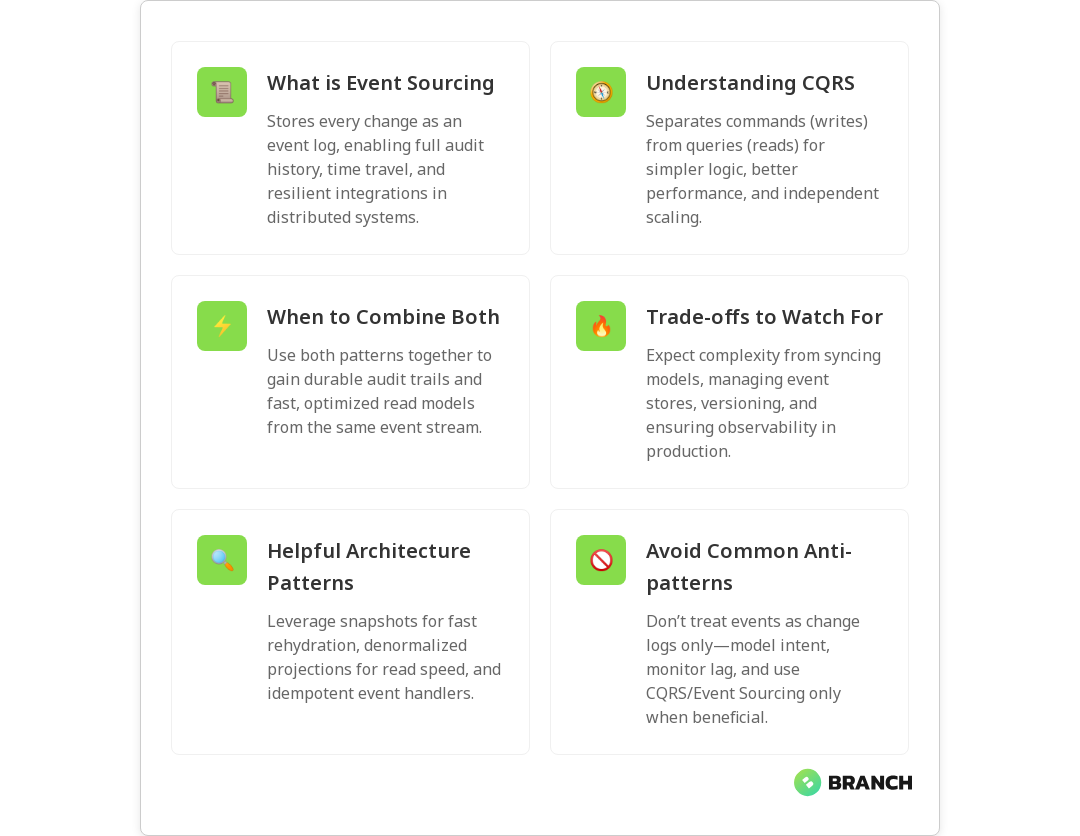Event sourcing and CQRS are two patterns that often show up together in modern systems architecture conversations — like peanut butter and jelly, but for data. They solve different problems: event sourcing captures every state change as an immutable record, while CQRS separates how you write data from how you read it. In this article you’ll learn what each pattern does, when and how to combine them, the trade-offs to watch for, and practical tips for implementing them in real-world systems.
Why these patterns matter today
Modern applications demand scalability, traceability, and flexibility. Traditional CRUD models can become brittle when you need auditability, temporal queries, or independent optimization of read and write workloads. Event sourcing and CQRS address those concerns by changing how you think about state and queries:
- Event sourcing records every change as an immutable event log, giving you a complete audit trail and the ability to rebuild state at any moment.
- CQRS splits command (write) and query (read) responsibilities so you can optimize each side independently — faster reads, simpler write logic, or different storage technologies.
Major cloud providers and architecture guides recommend these patterns as building blocks for resilient, scalable systems — see Microsoft’s guidance on event sourcing and their separate guidance on CQRS for more technical background.
Core ideas: Event sourcing explained
Event sourcing replaces the typical “store the current state” approach with “store every state change as an event.” Instead of updating an account balance field, you append an event like AccountCredited or AccountDebited. The current state is then computed by replaying the events.
Benefits include:
- Auditability: you have the full history of what happened and why.
- Temporal queries and time travel: reconstruct state at any point in time.
- Resilience for microservices: events are natural integration points between services.
Costs and trade-offs:
- Increased complexity: event design, versioning, snapshots, and replay logic add engineering overhead.
- Storage and operational concerns: event stores must be managed and scaled, and long event histories can require snapshots to speed up rehydration.
For practical guidance about combining event sourcing with CQRS and using event streams to power read models, AWS offers pragmatic advice in their prescriptive guidance on team-oriented service design and event-driven persistence patterns: AWS prescriptive guidance.
Core ideas: CQRS explained
CQRS (Command Query Responsibility Segregation) says: separate the models you use to modify state (commands) from the models you use to read state (queries). That separation lets you design each model for its specific purpose. For example, write model logic can focus on enforcing business rules while read models can be denormalized and optimized for fast queries.
Benefits include:
- Performance: read stores can be tuned for low-latency queries without affecting write throughput.
- Scalability: scale reads and writes independently to match demand.
- Clarity: command handlers and query handlers remain simpler and more focused.
Limitations and implications:
- Eventual consistency: reads may lag behind writes unless you engineer for synchronous update paths.
- Operational complexity: maintaining multiple data stores and synchronization pipelines requires discipline.
Microsoft’s CQRS guidance explains how separation can simplify design and when combining CQRS with event sourcing is appropriate for auditability and flexible model evolution: CQRS guidance.
How they work together: event sourcing + CQRS
Event sourcing and CQRS are often combined. The typical flow looks like this:
- Commands arrive at the write model which appends events to an event store (event sourcing).
- Event handlers create projections or materialized views optimized for queries (CQRS read model).
- Reads use the materialized views; writes use the event store and business logic.
This combination gives you a durable, auditable source of truth (the event log) and fast, tailored read models for different parts of your system. Practical patterns include using event streams to update in-memory databases for heavy-read endpoints and replaying events to recompute state after a model change, as recommended in cloud architecture guidance such as Microsoft’s event sourcing docs and AWS prescriptive patterns.
Projections, snapshots, and replays
Because replaying a long event stream for each request would be slow, systems use projections (materialized views) and snapshots:
- Projections consume events and project current state into a read-optimized store (SQL, NoSQL, search index, in-memory cache).
- Snapshots save a computed state periodically so rehydration needs only events since the last snapshot.
- Replays let you rebuild projections after code changes or to handle schema evolution.
Microservices patterns documentation also recommends pairing event sourcing with CQRS into sagas or process managers when coordinating long-running transactions across services: Event sourcing patterns.
When to choose one, the other, or both
Practical rules of thumb:
- Use plain CRUD if your data model is simple, audit needs are low, and you want to minimize complexity.
- Use CQRS without event sourcing if you want separate read/write models but don’t need full event history (easier to adopt).
- Use event sourcing if you need full audit trails, temporal queries, or strong traceability across business flows.
- Use event sourcing + CQRS when you need the auditability of events plus read performance from optimized projections.
Choosing depends on product requirements, team expertise, and operations readiness. If you’re building systems that will power analytics or machine learning, designing a robust event pipeline can feed downstream models and help with reproducible training data — read more about how data engineering supports AI in our overview of Data Engineering for AI – it explains why well-structured data foundations help AI projects succeed.
Operational considerations and pitfalls
Adopting these patterns affects your entire stack — not just the application code. Consider:
- Event store selection: durability, ordering guarantees, retention policies, and tooling. Kafka, EventStoreDB, and cloud-native event stores each behave differently.
- Schema evolution: events are immutable, so versioning of event formats and backward/forward compatibility strategies are essential.
- Monitoring and observability: you must track event processing, projection lag, and failed consumers.
- Recovery and replay: plan for replays to update projections and test them regularly to avoid surprises.
- Consistency models: communicating eventual consistency to product and UX teams is critical to avoid surprises for users.
Cloud and infrastructure teams also need to design infrastructure-as-code, backups, and cost controls for event storage — topics we go into in our Infrastructure as Code writeup, which highlights automation and governance strategies for operational reliability.
Patterns and anti-patterns
Helpful patterns:
- Design for idempotency: event handlers should handle duplicate events safely.
- Use time-based snapshots to speed up rehydration.
- Keep read models denormalized and purpose-built for queries.
- Adopt a robust event versioning strategy and backward-compatible consumers.
Common anti-patterns:
- Treating events as mere change logs without modeling intent — events should represent business facts.
- Using event sourcing to “replace” a relational design without clear benefits.
- Failing to instrument and monitor projection lag, leading to unexpected stale reads.
Trends and ecosystem
As organizations move toward event-driven microservices and real-time analytics, the ecosystem around event sourcing and CQRS is growing. Cloud providers publish prescriptive guidance for combining these patterns at scale — for example, Microsoft’s architecture center gives practical steps for modeling and materializing views from events, and AWS prescriptive guidance covers team-level service design with event streams and sagas. For approachable explanations and practical patterns, see the Mia-Platform overview on understanding event sourcing and CQRS: Understanding Event Sourcing and CQRS.
Practical starter checklist
- Define the business reasons: audits, time travel, scaling reads, or cross-service integration?
- Start small: implement CQRS first for a high-read endpoint, then consider event sourcing if audit/history becomes required.
- Pick an event store and projection technology that your team can operate reliably.
- Design event schemas thoughtfully and version them from day one.
- Invest in monitoring, replay tests, and documentation for event handlers and projections.

FAQ
What is modern data architecture?
Modern data architecture is an approach that emphasizes scalable, flexible, and often event-driven designs to support analytics, operational applications, and integrations. It typically includes data pipelines, event streams, materialized views, and cloud-native storage to enable real-time insights and reproducible data processing.
What is the difference between data architecture and data management?
Data architecture is the blueprint — the models, storage choices, flows, and integrations that determine how data moves and is stored. Data management is the operational discipline that enforces quality, governance, security, and lifecycle policies across that architecture.
How to create a data architecture?
Start by mapping business requirements: what data is needed, who consumes it, and how fresh it must be. Choose storage and processing patterns (batch, stream, event-driven), define schemas and contracts, and then implement pipelines, monitoring, and governance. Iterate with stakeholders and build reusable components.
What is a data architecture framework?
A data architecture framework is a structured approach or set of guidelines for designing and implementing data systems. It includes standards for data modeling, storage choices, integration patterns, governance, and security. Frameworks help teams make consistent, repeatable decisions.
What are the two main components of data architecture?
At a high level, the two main components are the data storage/processing layer (where data is persisted and transformed) and the data access/integration layer (how applications and analytics systems read and consume that data). Event-driven systems add an event bus or event store as a core component as well.




